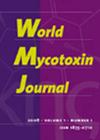发酵乳清和南瓜提取物对Jurkat t细胞黄曲霉毒素B1和赭曲霉毒素A毒性的保护作用
IF 2.2
4区 医学
Q3 FOOD SCIENCE & TECHNOLOGY
引用次数: 5
摘要
通过蛋白质组学方法,研究了富含类胡萝卜素的发酵乳清和南瓜提取物对Jurkat细胞黄曲霉毒素B1 (AFB1)和赭曲霉毒素A (OTA)细胞毒性的有益作用。将这些功能成分添加到霉菌毒素污染的面包配方中,体外消化模拟人体肠道吸收。将细胞培养物暴露于这些真菌毒素中7天:(a) 0.1%有机溶剂(DMSO), (b)单独添加南瓜的面包肠消化液(PID)和(c)添加南瓜和发酵乳清的面包肠消化液(PID+WF)。提取的蛋白质进行还原和烷基化,随后进行胰酶消化,以便通过液相色谱法和四极杆飞行时间(LC/MS-Q-TOF)进行分析。通过鉴定参与多种生物过程和代谢途径(主要是抗氧化活性、核小体组装和分泌性衰老表型)的蛋白质,所获得的结果突出了功能性成分的有益作用。在参与抗氧化活性的蛋白质中,过氧化氧还蛋白1和2尤为突出。比较不同条件下的研究,观察到它们的表达发生了显著变化,从使用标准(DMSO 0.1%)抑制到使用功能成分处理时的过表达。同样,PID和PID+WF处理后,与核小体组装代谢途径相关的组蛋白,如H2A、H2B、H2C、H3和H4的表达增加。此外,在两种功能成分的存在下,细胞周期蛋白A2的表达水平降低,而细胞周期蛋白A2的下调参与了限制致癌细胞的生长。基于这些发现,功能性成分可以作为防止真菌毒素引起的基因组压力的保护剂,防止重要细胞功能的丧失,并使致癌细胞的生长瘫痪。本文章由计算机程序翻译,如有差异,请以英文原文为准。
Protective role of fermented whey and pumpkin extract against aflatoxin B1 and ochratoxin A toxicity in Jurkat T-cells
The beneficial effect of fermented whey and pumpkin extract rich in carotenoids was evaluated in Jurkat cells against aflatoxin B1 (AFB1) and ochratoxin A (OTA) cytotoxicity through a proteomic approach. The functional ingredients were added into mycotoxin contaminated bread formulation, which were digested in vitro in order to simulate human intestinal absorption. Cell cultures were exposed during 7 days to these mycotoxins dissolved in: (a) 0.1% organic solvent (DMSO), (b) an intestinal digest of bread with pumpkin individually (PID) and (c) an intestinal digest of bread with pumpkin mixed with fermented whey (PID+WF). Extracted proteins were subjected to reduction and alkylation and subsequently a tryptic digestion in order to be analysed by liquid chromatography coupled with quadrupole time of flight (LC/MS-Q-TOF). Results obtained highlighted the beneficial role of functional ingredients employed through the identification of proteins involved in several biological processes and metabolic pathways, mainly antioxidant activity, nucleosome assembly and secretory senescence phenotype. Among proteins involved in antioxidant activity, peroxiredoxin 1 and 2 stand out. Comparing the different conditions investigated, a remarkable change was observed in their expression, ranging from a repression using the standard (DMSO 0.1%), to an overexpression when treated with the functional ingredients. Similarly, after PID and PID+WF treatment, histones’ expression implicated in the metabolic pathway of nucleosome assembly, such as H2A, H2B, H2C, H3 and H4, was increased. Furthermore, the expression of protein cyclin A2, which downregulation is involved in limiting carcinogenic cells growth, was lower in presence of both functional ingredients. Based on these findings, functional ingredients can act as protectors against genomic stress caused by mycotoxins, preventing the loss of vital cell functions and paralysing the growth of carcinogenic cells.
求助全文
通过发布文献求助,成功后即可免费获取论文全文。
去求助
来源期刊

World Mycotoxin Journal
MYCOLOGY-
CiteScore
4.60
自引率
5.00%
发文量
25
审稿时长
>12 weeks
期刊介绍:
''World Mycotoxin Journal'' is a peer-reviewed scientific journal with only one specific area of focus: the promotion of the science of mycotoxins. The journal contains original research papers and critical reviews in all areas dealing with mycotoxins, together with opinions, a calendar of forthcoming mycotoxin-related events and book reviews. The journal takes a multidisciplinary approach, and it focuses on a broad spectrum of issues, including toxicology, risk assessment, worldwide occurrence, modelling and prediction of toxin formation, genomics, molecular biology for control of mycotoxigenic fungi, pre-and post-harvest prevention and control, sampling, analytical methodology and quality assurance, food technology, economics and regulatory issues. ''World Mycotoxin Journal'' is intended to serve the needs of researchers and professionals from the scientific community and industry, as well as of policy makers and regulators.
 求助内容:
求助内容: 应助结果提醒方式:
应助结果提醒方式:


